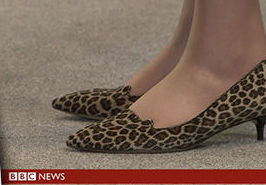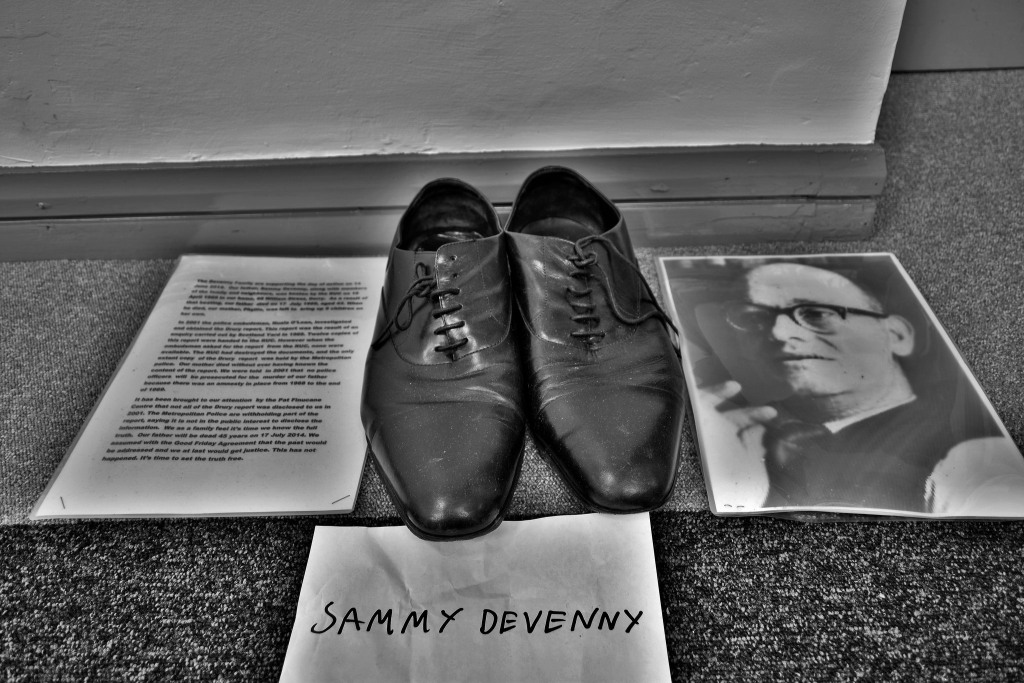In the gut-punchingly brilliant season finale of Derry Girls, a glimpse into the editorial decision-making process of the staff of The Habit revealed that their news list for the latest issue consisted of just two articles, each genius in their own way.
Not that the team at Northern Slant operates with anything remotely like the same panache, but we thought the girls might be onto something, and – since they weren’t using them – we crowdsourced which of their proposed exclusive exposes you might like to read.
Help our editorial team out. We’re finding it hard to decide on our next feature article… #DerryGirls
— Northern Slant (@NorthernSlant) February 8, 2018
Everyone’s favourite editor-in-chief Sister Michael clinched it while attempting to censor the issue that eventually appeared, when she asked: “Whatever happened to Shoes of The World?” So, by way of an answer, here’s a look at some famous shoes and the symbolism of protest…
Shoeplomacy
 In one of the most iconic shoe-related political incidents, Soviet premier Nikita Kruschev brandished his shoe at a meeting of the UN in 1960, in response to allegations that the USSR had “swallowed up” Eastern Europe. We say “brandished” since while common myth has it that he “banged” his shoe in anger, there’s some disagreement whether he actually banged it on the podium or just waved it about a bit, in the theatrical way that Soviet leaders of the black-and-white era were prone to do.
In one of the most iconic shoe-related political incidents, Soviet premier Nikita Kruschev brandished his shoe at a meeting of the UN in 1960, in response to allegations that the USSR had “swallowed up” Eastern Europe. We say “brandished” since while common myth has it that he “banged” his shoe in anger, there’s some disagreement whether he actually banged it on the podium or just waved it about a bit, in the theatrical way that Soviet leaders of the black-and-white era were prone to do.
There was no such doubt about whether President George Bush experienced anger-related footwear when, at a press conference with Iraqi prime minister Nouri-al-Maliki in Baghdad in 2008, journalist Muntather Zaidi screamed about “widows and orphans of those killed in Iraq” as he hurled both his shoes at Bush, who appeared bemused at first by what was happening. Zaidi was jailed for a year, and the incident gave rise to the modern concept of “shoeing” as a public insult and provoked several copycat events.
Former British Prime Minister Tony Blair had shoes – and eggs – thrown at him by activists protesting against the war in Iraq when he showed up at Eason’s in Dublin to promote his book “My Journey” in 2010; while a number of other prominent figures, from Hillary Clinton to Iranian President Mahmoud Ahmedinijad, to IMF chief Dominique Strauss-Kahn, have been targeted by footwear-flingers. Former Australian Prime Minister John Howard, though, is thought to be the only world leader to be the subject of two separate shoeing incidents.
A much more chilling form of shoe violence, of course, was when British-born Richard Reid tried to use a shoe-bomb to blow up an American Airlines flight from Paris to Miami in 2001. In letters from prison, where he is serving a life sentence, he said he believed his failure to destroy the plane was because “it wasn’t supposed to happen… it was not either my time to die nor that of those on the plane with me.” The shoes Reid was wearing are on display at the Newseum in Washington DC.
Downtrodden
 Former first lady of the Philippines, Imelda Marcos was known for the extravagance of her shoe collection as much as her husband, dictator Ferdinand Marcos, was feared for the sort of brutality that has inspired the country’s current leader, Rodrigo Duterte. As The Guardian reported, when the Marcoses fled after the 1986 uprising, “the new president Corazon Aquino had Imelda Marcos’s shoes displayed at the presidential palace as a symbol of the former first lady’s lavish lifestyle. The shoes became a symbol of excess in a nation where many still walked around barefoot in abject poverty.” Many of the shoes were subsequently destroyed by storm damage and termites.
Former first lady of the Philippines, Imelda Marcos was known for the extravagance of her shoe collection as much as her husband, dictator Ferdinand Marcos, was feared for the sort of brutality that has inspired the country’s current leader, Rodrigo Duterte. As The Guardian reported, when the Marcoses fled after the 1986 uprising, “the new president Corazon Aquino had Imelda Marcos’s shoes displayed at the presidential palace as a symbol of the former first lady’s lavish lifestyle. The shoes became a symbol of excess in a nation where many still walked around barefoot in abject poverty.” Many of the shoes were subsequently destroyed by storm damage and termites.
Heels
Before Theresa May became British Prime Minister, The Sun described her as a “shoe fanatic whose childhood dream was to become a politician” and while her footwear may have been more of a focus of her political persona before she got the top job and was less well-known, it clearly isn’t something she has been able to shake. Nor have those who cover her been able to let it go, apparently. Take this opening paragraph, for example: “The BBC has been blasted for trivialising the contentious Brexit talks after a report on the divorce bill included a bizarre focus on Theresa May’s shoes. During a broadcast bulletin on the latest updates surrounding the divorce bill settlement, the report featured cutaways of the Prime Minister’ leopard-print heels.”
 She even told a TV show ahead of last year’s election that her shoes had inspired a young woman to enter politics. Needless to say that didn’t go down well on social media.
She even told a TV show ahead of last year’s election that her shoes had inspired a young woman to enter politics. Needless to say that didn’t go down well on social media.
So worry not; while Brexit continues to roil in uncertainty and borderline national economic self-harm, and the failure of devolved government in Northern Ireland hangs over her head, the Prime Minister can always rely on the Telegraph to cut to the chase with stories like “Are Theresa May’s shoes fashion faux pas or stylish self-expression?”
Running for office
In two political protests from the US, the protagonists’ shoes played a big part in the press coverage. When Texas state senator Wendy Davis broke onto the national stage in 2013 by way of an 11-hour filibuster against a piece of abortion legislation, her choice of red Mizuno sneakers ended up being a focus for how she was able to stay on her feet for so long. The Washington Post reported on how “proper filibuster footwear is an issue that knows no gender.”
The Post also wrote earlier this month how, when minority leader of the House Nancy Pelosi “gave a modern record-setting eight-hour speech … the fact that she was wearing four-inch stilettos got almost as much attention as the immigration issue that had prompted her to take the floor.” Karen Tumulty wrote at the time:
Shoes on a powerful woman do more than just get her from one place to another. They can declare her female identity and her determination to power through to victory on an uneven playing field.
Lost Soles
Away from the world of politics, one of the strongest visual symbols of US inner-city life has been tied sneakers hanging over telegraph wires – often as territorial or gang-related markers to outsiders – a problem of interpretation being that, depending on the city, or even the area of the city, if “you talk to 200 different people, you’re probably going to get 200 different answers.” Australian filmmaker Matt Bate tried to get to the bottom of the phenomenon in a documentary entitled The Mystery of Flying Kicks.
Finally, what looks like being one of the most intriguing and poignant exhibits at next month’s Imagine Belfast festival will be ‘In Their Footsteps’ a collection of shoes donated by families who lost a loved one during our years of conflict. According to the festival literature, the exhibit represents a call for “the British and Irish governments to implement an acceptable and effective mechanism to deal with the past. To date the families have shown this powerful exhibition in Dublin, Belfast, London, Derry and Stormont.”
One of the groups helping to organize the project is the Pat Finucane Centre, which says: “What is unique about this campaign is that all the victims here are represented equally, regardless of the status of the victim or who the perpetrator was, or whether their loved one was killed as part of a mass atrocity or in a single incident. That is why it is so powerful. There is no hierarchy of victims. The families are united in asking for the past to be dealt with.”

Also published on Medium.
